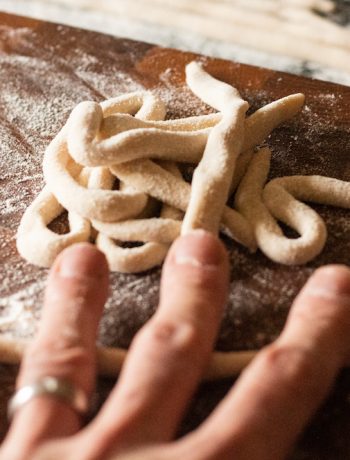Derived from the French ‘tapeno‘ meaning ‘capers,’ tapenade is not a showcase for olives. In a good tapenade, olives are merely the vehicle for the caper-forward taste. Hailing from Provence, tapenade combines the saltiest ingredients on God’s given Earth to create a gorgeous dipping sauce for crudities, a marvellous spread for crackers and a spectacular garnish for eggs and fish. Tapenade in its modern form is believed to have been invented in 1880 by Chef Meynier at the La Maison Dorée restaurant at 20 Bd des Italiens, 75009 Paris, France. The site of the restaurant is now occupied by BNP Paribas.

Despite the claimed invention, the combination of ground olives and fish points directly at a Roman origin. Cato the Elder (234–149 B.C.) wrote a recipe for’ epityrum,’ which is an olive spread that bears much resemblance to tapenade. Cato wrote thusly:
“Epityrum album nigrum variumque sic facito. Ex oleis albis nigris variisque nuculeos eicito. Sic condito. Concidito ipsas, addito oleum, acetum, coriandrum, cuminum, feniculum, rutam, mentam. In orculam condito, oleum supra siet. Ita utito.”
This translates to:
“White, black, and mottled epityrum is made this way. Remove the pits from the white, black, and mottled olives. Prepare them as such: break them down, add oil, vinegar, coriander, cumin, fennel, rue, and mint. Arrange it in a small jar, pour over oil, and eat it thus.”
Add the capers and some fish (e.g. Roman ‘garam‘), and you pretty much have a tapenade right there — 200 years before the birth of Christ.
The recipe given here is adapted from Larousse. We have decreased the quantity of anchovies and use quantities suitable for UK supermarket shopping (e.g. the deli olives from Tesco).
Tapenade
Ingredients
- 300g kalamata olives, pitted (use a pitting tool if you have stones; weight is given with the stones)
- 6 white anchovy fillets
- 80g canned tuna
- 2 garlic cloves, peeled
- 2 tbsp capers, rinsed
- Juice of 1 lemon
- About 75ml very good extra-virgin olive oil
- Freshly ground black pepper
Instructions
Blitz the first 6 ingredients in a food processor. Gradually add the oil until a slightly oozing consistency is achieved (not a loose as pesto, but not as stiff as peanut butter). Season with pepper only.
Notes
The Larousse original additionally passes the mixture of solids only through a fine sieve before adding any liquid. This results in a smoother tapenade.






No Comments